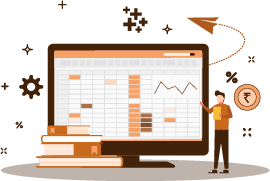What is a balance sheet?
A balance sheet is a statement of assets, liabilities and capital of an organisation as on a particular date. In short, it shows what a company owns and owes. Additionally, it shows the amount invested in the business. A long with other financial statements helps to calculate the profitability, liquidity, leverage and efficiency of a business.
A balance sheet has assets on one side and liabilities and capital on the other side. Both the sides are always equal.
Therefore, Assets = Liabilities + Capital.
Where:
Assets are what the company owns.
Liabilities are what the company owes.
And, capital is what has been invested in the business.
Importance
It is important because it helps in understanding the performance of a company. Following are the reasons why it is important:
- To understand the financial health of a company.
- Stakeholders can study the balance sheet to understand the liquidity position and business performance of the company.
- Comparing balance sheets over the years helps in determining the growth of the company.
- It is an essential document to obtain a business loan.
- Analysing the company’s balance sheet helps in understanding the ability of the firm to undertake expansions projects and unforeseen expenses.
- It helps in identifying the source of company funding, for example, equity funding or debt funding.
Purposes
The primary purpose of a balance sheet is to provide the financial position of a company as on a particular date. It provides a snapshot of the company’s equity, assets and liabilities for a financial year. Analysing the three categories helps in understanding the financial standing, liabilities, liquidity position and growth of the company. Analysts use it to analyse a company to understand its profitability, liquidity, leverage and efficiency of a business. Also, along with the profit and loss statement helps in analysing the company’s financials.
Components
Following are the The two components
- Assets: All the items that a company owns having a tangible value fall under assets. Assets are further classified as current assets and non-current assets based on liquidity. Current assets include cash in hand, account receivables and inventory. In comparison, non-current assets do not have high liquidity. Also, these cannot be converted to cash within the next year.
- Liabilities: It is what the company owes to its debtors. Similar to assets, liabilities have current liabilities and non-current liabilities. Current liabilities are the obligations that the company has to fulfil in the next year. While non-current liability is long term debt. For examples, these are loans the company takes.
It also has a shareholder’s equity. It is the capital contributed to the business by the shareholders.
What is a balance sheet reconciliation?
Balance sheet reconciliation is a process of comparing balance sheet item with the accounts that make up the balances. Therefore, balance sheet reconciliation confirms that each account is accurate, consistent and complete. Reconciliation helps in identifying transactions that have not been recorded or that have been recorded twice. It also helps in tracking expenses, revenue and reserves. Furthermore, it is suggested that reconciliations should be done at regular intervals. This ensures accuracy in accounts from time to time.
What is the balance sheet equation?
The balance sheet equation or account equation is the primary principle of accounting. It is the base of the double-entry system.
The accounting equation is Assets = Liabilities + Capital.
The assets are what the company owns. The liabilities are what the company owes. Liabilities and assets together represent how the assets are financed. Therefore, any business transaction that occurs will have a dual effect, automatically balancing the accounting equation.
How to prepare a balance sheet?
It shows the financial position of a business as on a particular date. Hence preparing it becomes vital for the business to know what it owns and owes. The following steps will help one to prepare it.
- Determine the frequency of preparing (It’s usually done quarterly, and annually)
- Identify and estimate the assets and liabilities.
- Calculate the capital or shareholders’ equity
- Prepare the balance sheet by listing out shareholder’s equity, liabilities and finally the assets. The assets should be equal to the sum of the shareholder’s equity and liabilities.
RELATED PAGES


















Show comments